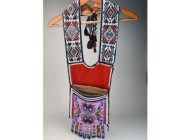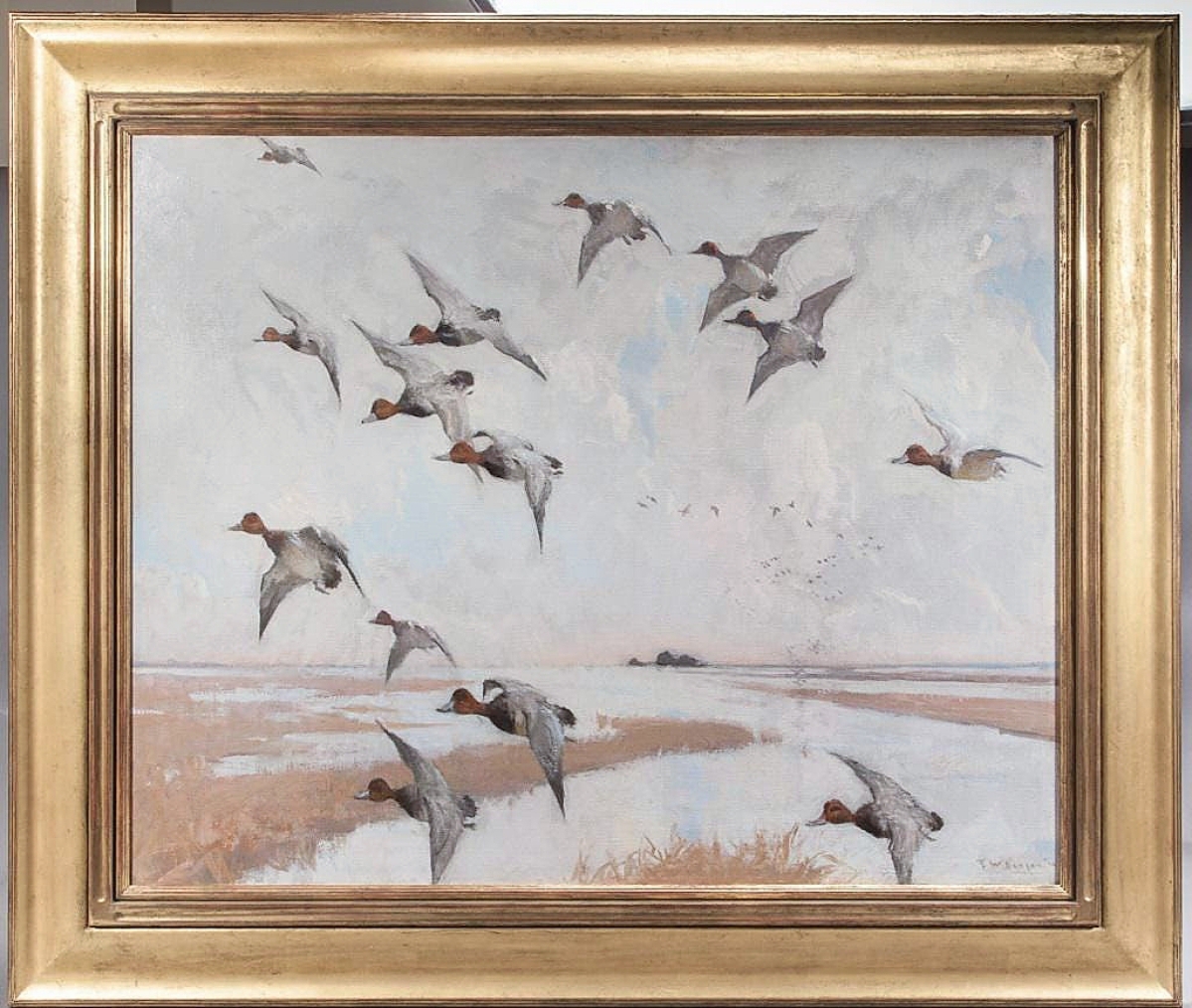
At $270,000, “Redheads in Flight” by Frank Benson was the highest priced item in the auction. Few early oil paintings of waterfowl by Benson are known to exist. This one was probably inspired by time Benson spent at the Long Point hunt club on Lake Erie. The catalog includes extensive details, with quotes by the artist, of his hunting experiences at the club.
Review by Rick Russack, Photos Courtesy Copley Fine Art
HINGHAM, MASS. – Copley’s February 19-20 sale included part two of the Peter Muller Jr decoy collection, along with items from the collections of the late Bill DuPont, Walter Bush, Dale Farrell, Ted and Judy Harmon and several others. The offerings of sporting art were especially strong and produced some of the highest prices of the two-day sale, with paintings by Frank Benson, Edmund Osthaus, Ogden M. Pleissner, and Arthur Fitzwilliam Tait among others. The sale included seven lots that brought more than $100,000, three of which were paintings, and more than 80 other lots brought five-figure prices. The sale was live-streamed from Copley’s Hingham gallery, with auctioneer Peter J. Coccoluto handling the podium responsibilities. When the counting was done, the sale totaled $4,880,394.
Material was available for inspection at the gallery and other ways. A few weeks before the sale, O’Brien loaded up his car and took a one-week tour through six Southern states, meeting with 23 collectors and showing decoys to those interested. Colin McNair, Copley decoy specialist, also took decoys on a road trip, and between the two of them, collectors in 14 states were offered the opportunity for hands-on previews. In addition, personalized video previews were offered so collectors could examine particular decoys up close, while discussing the item with O’Brien or McNair. All decoys in the Muller collection were examined under black light to discern if there had been later paint. More than 200 birds were x-rayed so that internal details and possible repairs or replacements would be noted.
The highest grossing lot in the sale, finishing at $270,000, was “Redheads in Flight,” an oil on canvas by Frank Benson (1862-1951), signed and dated 1916. The painting, likely inspired by a hunting trip to a Lake Erie hunt club, was cataloged as one of only a very few early oils of waterfowl by Benson known to exist. The catalog devotes ten pages to a description of this painting, its provenance and Benson’s experiences at the Long Point hunting club. It includes quotations from Benson’s hunting diary relating to Long Point, including some records of the birds he shot. “Jimmy’s Pool on the Restigouche,” signed and dated 1938 by Ogden M. Pleissner (1905-1983), earned $240,000. More than 30 major museums own examples of his work, and when the Metropolitan Museum of Art acquired one of his paintings in 1932, he was the youngest artist in its collection. The extensive catalog description includes quotes from his writings. Rounding out the three paintings that brought six-figure prices, finishing at $180,000 was “Pointer with Quail” by Edmund H. Osthaus (1858-1928), signed and dated 1890. He raised and showed hunting dogs, was a field trial judge and was intimately familiar with canine physiology. Osthaus was commissioned by industrialists, such as J.P. Morgan and members of the Vanderbilt family, to paint sporting scenes for them.
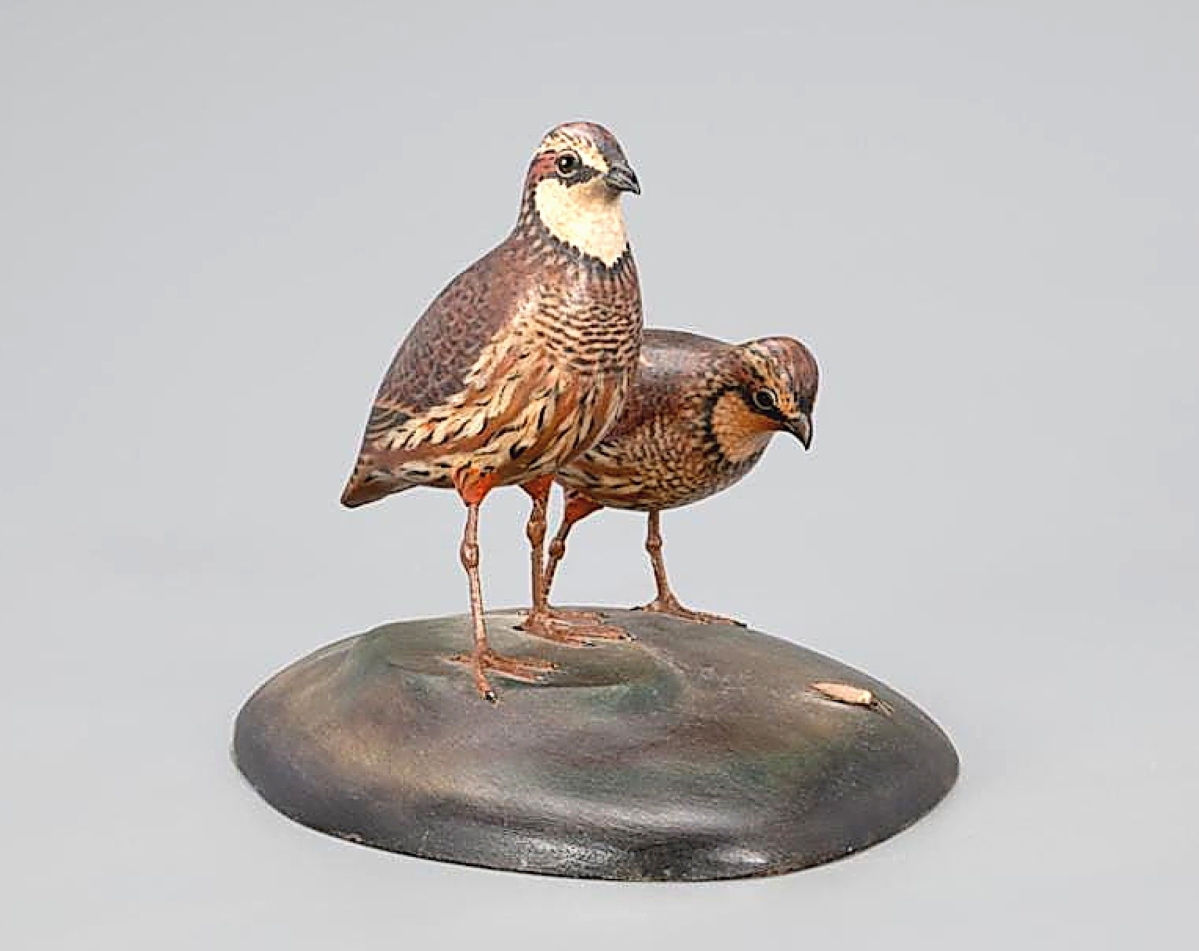
At $221,400, more than three times the estimate, Elmer Crowell’s life-size carving of a pair of bobwhite quail, on a double mount, was the highest priced carving in the sale. It was also the highest auction price for an upland carving of any species. Although upland game birds are not often seen on Cape Cod now, they were much more common in Crowell’s day. It was signed and dated 1938.
Leah Tharpe, Copley’s fine art specialist, noted shortly after the sale that results were strong. “The group of paintings from the Dale Farrell collection performed well,” she said. “His seven coastal paintings collectively earned about $110,000. Emile Gruppe’s masterwork ‘On Fish’ led the group, selling for $55,200, the second highest price for the artist at auction. New world records were set for Chet Reneson at $13,530 for his fishing scene ‘Island Clouds,’ and Maynard Reece, at $9,225 for ‘Mallard Ducks, Banking for Landing,’ among others. And it’s always nice for me to see a painting like Benson’s ‘Red Heads in Flight’ at the top of the list.”
Decoys included works by many of the established masters: Elmer Crowell, Joe Lincoln, members of the Cobb family, the Ward Brothers, Obediah Verity and other Long Island carvers, Ira Hudson and many more. There were working decoys, decorative carvings, miniatures and decoys produced by some of today’s contemporary masters. Steve O’Brien and his team produced two catalogs totaling nearly 500 pages with hundreds of color photos, including numerous photos of particular details, vintage photos, biographies of the collectors, carvers and artists, along with detailed descriptions of the offerings. The catalogs are a great learning tool and permanent record for both seasoned collectors and those new to the field.
Several of the decoys offered throughout the sale had distinguished pedigrees, having been, at one time or another, in some of the most notable collections. The sale catalog was organized by collector, which perhaps provided some insight as to how premier collectors viewed their birds and what directions their collection might take.
The first 40 lots of the sale, in a separate 140-page catalog of their own, were part two of the Peter J. Muller collection and generated some of the highest decoy prices of the auction. Muller died in 2019 and the first part of his collection had been sold by Copley in February 2020, grossing more than $1.5 million. This part of the Muller collection grossed more than $1 million, finishing above the high estimate. Muller, who had been a veterinarian in “real life,” was a dedicated student of the field and, according to his wife, “radiographed every decoy he ever bought.” Several of the birds in the Muller collection had been in the William Mackey Jr collection, considered by many to have been one of the finest collections assembled in the United States. The Mackey collection was dispersed by the Richard Bourne auction house during 1973-74 in a series of four sales. Muller was a strong bidder at those Bourne sales and continued to add Mackey birds when the opportunity presented itself.
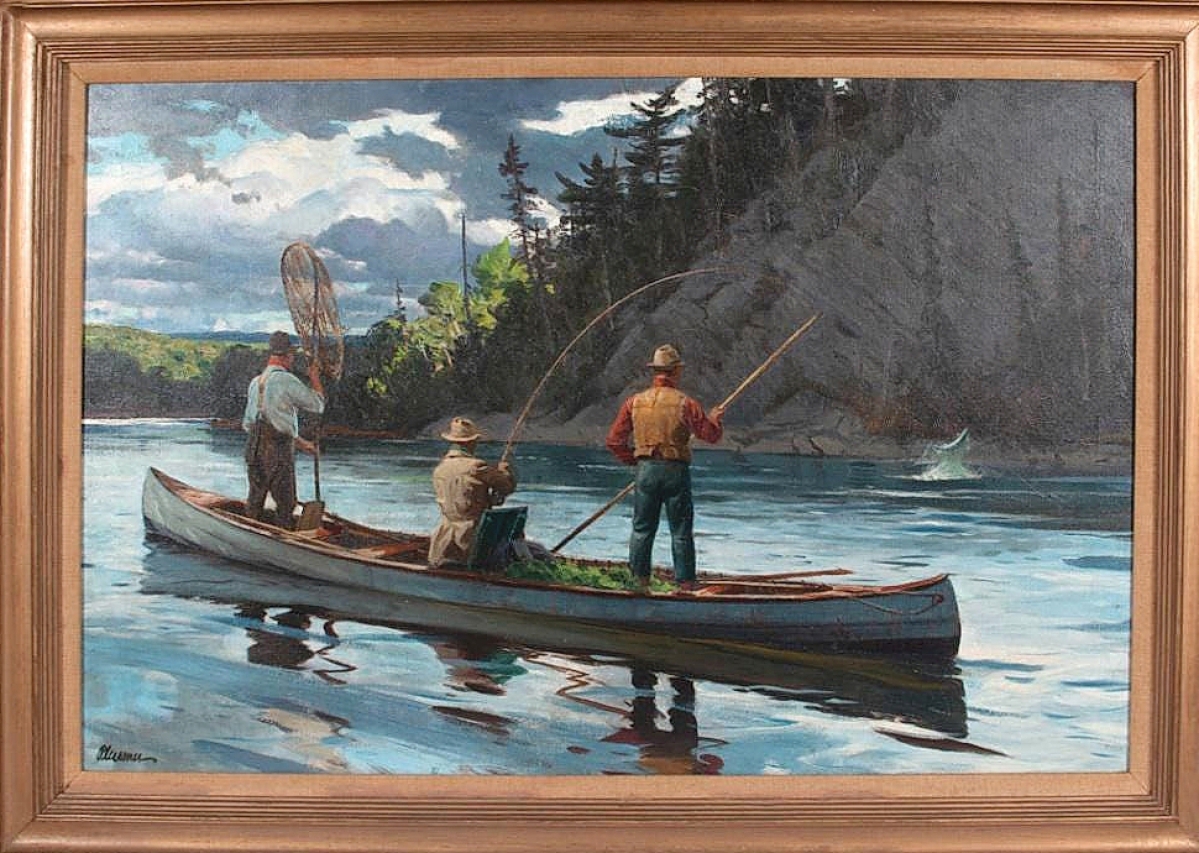
Ogden M. Pleissner’s 1938 oil “Jimmy’s Pool on the Restigouche” brought $240,000. It was the second highest auction result for the artist. When, in 1932, the Metropolitan Museum of Art acquired one of his paintings, it was noted that he was the youngest artist in its collection.
Three of the highest priced decoys in the sale were from the Muller collection, and two had been in the Mackey collection and bore his identifying stamp on the bottoms. These were two decoys made by Nathan Cobb Jr, one of the most sought-after carvers. Cobb’s Island, off the coast of Virginia, was a favorite resort of the rich and famous of the hunting world and frequented by many of the wealthiest sportsmen of the era, including political leaders. The island’s hotel, church, stores and homes were destroyed in a hurricane in 1896. (The full story of the Cobb family, and the hunting that took place on the island is fascinating and Copley’s catalog includes a great deal of information.) Few of Cobb’s decoys show the birds in feeding poses, and it was a feeding brant that earned $186,000, well over the estimate. The decoy’s provenance is well documented. It was used in the gunning rig of Cobb’s son, Elkanah, bears his stamp, along with the Mackey stamp, and it had also been owned by Ray Egan. Selling for $120,000 was a feeding curlew, also by Nathan Cobb Jr, also with impeccable provenance. The catalog stated that this decoy is the only known Cobb curlew in a true feeding posture. There were other Cobb decoys in the sale.
The Muller collection included a pair of circa 1932 canvasback ducks by Chesapeake Bay carvers, the Ward Brothers of Crisfield, Md., which sold for $129,000. Each was signed and dated. The pair also had a distinguished provenance, having been in the Purnell collection before going to Muller. Purnell was a friend and patron of the Ward brothers, and the decoy bears his stamp. The Muller collection was also strong in Long Island decoys, and the prices obtained demonstrated their quality. There were three shorebirds, made either by William Bowman or Charles Bunn. (Which man is the actual maker is disputed at this point in time, and further research is underway.) Regardless of which man made them, they are highly regarded by today’s collectors. A reaching yellowlegs with bold wing carving reached $50,400. A running turnstone with glass eyes finished at $45,600, and a willet by the same maker realized just a few dollars less, $45,000.
Taking nothing away from the Cobb birds in the Muller collection, the unexpected highest priced decoy in the sale was a carving by Elmer Crowell. A decorative carving of a life-size pair of bob-white quail, on a double mount with a caddisfly about to be eaten by one of the birds, realized $221,400, more than three times the estimate. The base is signed by Crowell and dated 1938. Although upland game birds are not often seen on Cape Cod these days, they were much more common in Crowell’s day. Another upland game bird by Crowell, a circa 1912 woodcock, sold for $90,000. Crowell carvings are always popular – he was prolific, and there are many Crowell collectors. Crowell carved dozens of species of miniatures. Some, waterfowl, shorebirds and songbirds were sold in sets of 25, but finding complete, original sets is very difficult. Most sets were broken up and dispersed over the years. A full set of 25 waterfowl, each signed and numbered 1-25, brought $56,850.
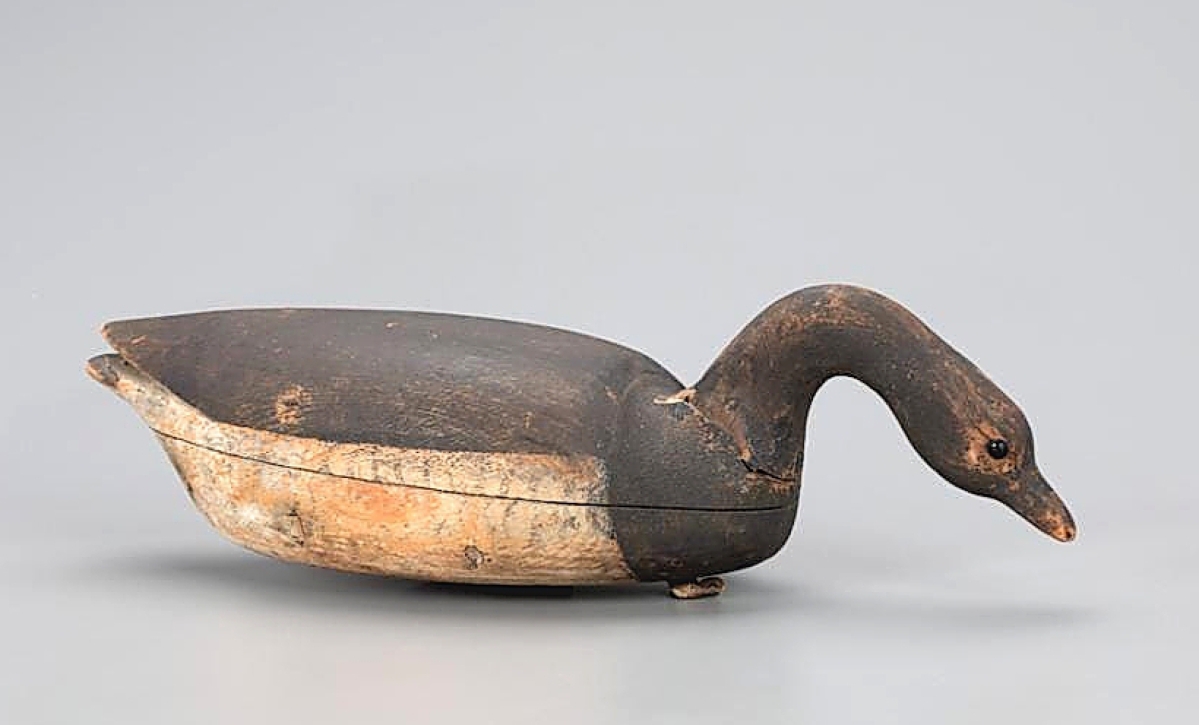
A feeding brant by Nathan Cobb Jr from the Muller collection earned $186,000. It had impeccable provenance having been used by Cobb’s son, bearing his stamp, along with the stamp indicating it had been in the Mackey collection.
The name Bill du Pont is well known to collectors and students of American furniture and accessories. Less well-known is the fact that he was an avid outdoorsman and collector of decoys and related items. Not surprisingly, decoys from the du Pont collection did well in this sale. A preening curlew by Crowell, signed and dated 1941, finished at $60,000. A 1935 flying merganser drake by Ira Hudson, a Virginia carver, that had been in the Mackey collection where it hung above his mantel, earned $46,800. A 1936 canvasback drake, made by the Ward brothers of Maryland, sold for $37,200. Du Pont’s collection was wide ranging, including inexpensive cast iron decoys, gun powder casks and tins, du Pont advertising broadsides for gun powder and punt guns. These were large, oversized shotguns that were used by market gunners to kill many birds with one shot. Use of these guns was outlawed by Congress in 1918. The du Pont collection grossed about $400,000, far over the high estimate.
While this article has reported final prices of decoys that are beyond the reach of some collectors, it should not be assumed that all decoys are expensive. This sale included numerous decoys and pieces of sporting art that sold for $500 and less.
O’Brien credits the sale of the Mackey collection as the “beginning of the way decoys are now valued and sold.” When asked, O’Brien commented that prior to the Mackey sale, a decoy collector’s library might have consisted of fewer than half a dozen titles whereas today, a quick count of the books in his library included more than 100 books on decoys of specific regions and specific carvers. “Today’s collector is well educated in their interests,” said O’Brien. “They know how prolific a given carver was, and which species that carver usually made, so they know which species are rare. They know the details a carver usually included, and those details less often used. They’re also in a better condition to evaluate condition. I think today’s buyers are less emotional about what they’re buying and more informed. That’s really good for the market.”
Joel Barber, whose 1934 book Wildfowl Decoys, one of the earliest in the field, was an avid collector, not a hunter, and he also tried his hand at carving. His goal was to produce the “perfect modern decoy.” Kory Rogers, curator of American art at the Shelburne Museum, described his efforts that way, at the time the museum mounted a special exhibition highlighting the Barber collection (one of America’s best public collections), housed at Shelburne. This sale included three of the decoys Barber produced around 1940, one of which, a canvasback drake, sold for $2,040. Only about 50 of his carvings are known to exist.
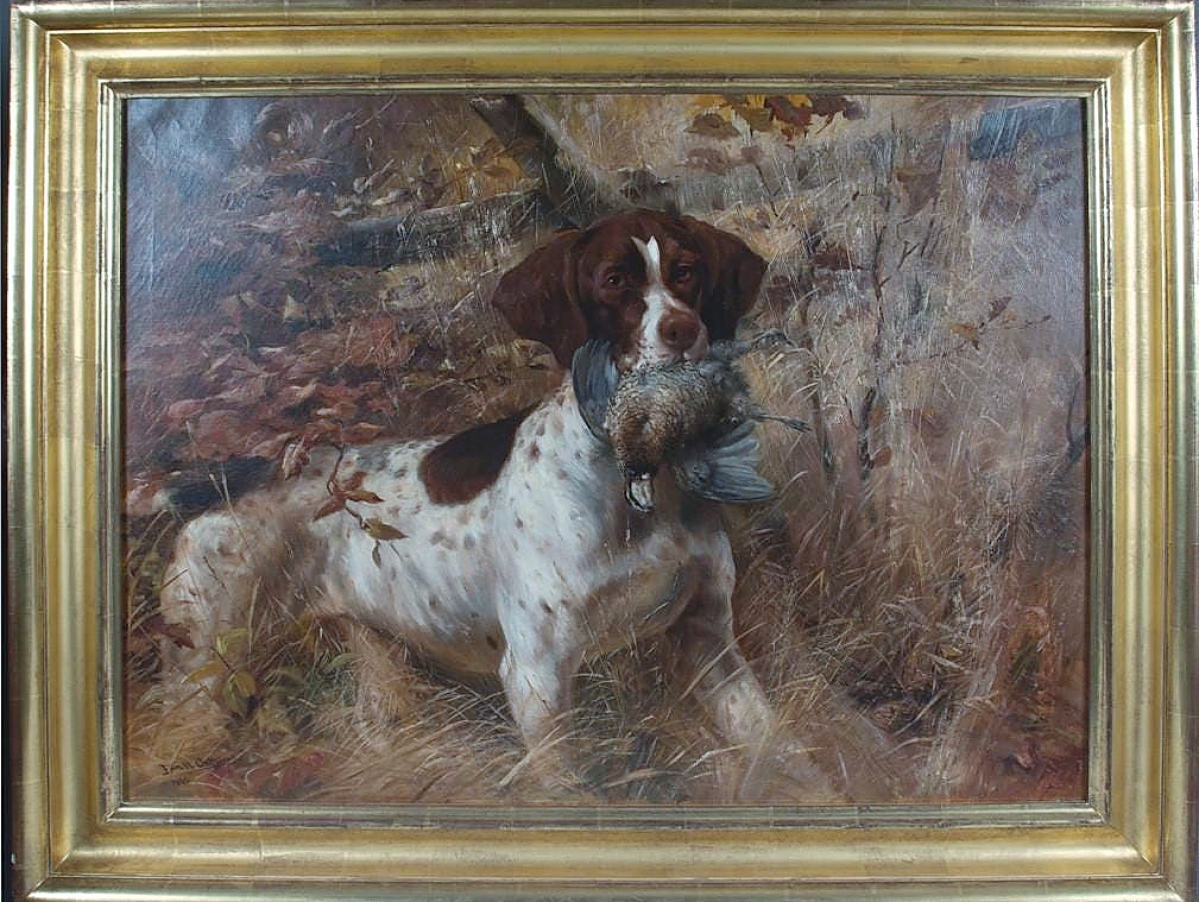
“Pointer with Quail” by Edmund H. Osthaus, signed and dated 1890, brought $180,000. The artist was often commissioned by the elite of the day, such as members of the Vanderbilt family, to create works for their homes.
The background of some of the decoys is instructive if one were to ask who some of the early collectors and hunters were. The answer, in many cases, is that the individuals were wealthy businessmen. Noted above are hunters’ clubs on Lake Erie and Cobb’s Island. The Monkey Island swan, which realized $42,000 from the Bush collection, is so named because it was used at the Monkey Island Club, a hunter’s club in North Carolina. Members included some of America’s wealthiest men, including the president of the American Tobacco company, other company executives and their friends. The island was purchased for $15 in 1869 by Norfolk investors who turned it into a private hunting club, with an eight-bedroom hunting lodge, a boathouse and a three-bedroom cottage. It eventually grew to include more than 1,000 acres, and in the 1970s was sold for $3 million. Often, decoy carvers acted as guides for these hunters, and often they created decoys specifically for these men that they knew well, with special features – extra fine carving, extra fine paint, etc., and often these special decoys adorned mantels rather than being used to hunt.
Decoy specialist Colin McNair during the preview was asked which were his favorite birds in the sale. “I’m a Southern boy, Virginia was home, so I especially like Southern decoys, and there were many in the Muller collection,” he said. “So the Nathan Cobb brant and feeding curlew would be at the top of my list. And the Lee Dudley black duck has such refined carving so it would be on my list as well.” After the sale, he said, “As I said, I like the Southern decoys, and I was glad to see the strength of the market for birds from that region. I especially enjoyed working on our catalog for this sale. People who knew and hunted with, or collected with, the men who assembled these collections are still active. We were able to talk to many of those people and record their first-hand stories. That part of the history of these collections could soon be lost, so being able to preserve that history is really important. And seeing records set for some of the things we sold is gratifying. Since our family carves today, it was really good to see a Canada goose carved in 1996 by Jim Schmiedlin set a record for a contemporary carver, when it finished at $60,000.”
A few days after the sale, a justifiably pleased Steve O’Brien noted that the Muller collection gross exceeded the firm’s high estimate. “The Muller collection was 98 percent sold. The gross of this sale, more than $4.8 million, is testament to the ‘eye’ of the collectors who assembled the collections we sold. These are the type of collections I wanted to deal with when I started this business. We saw strength at all levels of the market and an unprecedented number of new bidders – the new collectors we always talk about. The market is hot right now for miniatures, and we had some outstanding examples from outstanding collections. The miniature collection of Dr Oden was high quality and the final prices reflected that. The Sherer collection of miniatures was superb, with many exceeding high estimates. The du Pont collection, which along with decoys, emphasized the implements of waterfowling – the punt guns, the iron-winged birds used in sinkboats and the powder tins, showed his interest. It was also obvious to us that many collectors were looking for the best of the best – provenance mattered. All in all, we’re all very pleased with the results.”
Prices given include the buyer’s premium as reported by the auction house. For information, 617-536-0030 or www.copleyart.com.





































